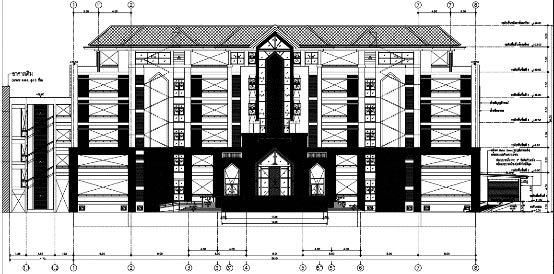Guideline of Educational Building development for Evaluation Energy efficiency : Case study of Educational Building and Operational Technology at Suan Sunandha Rajabhat University
Main Article Content
Abstract
Sustainable development about energy saving for Educational Building, It is found that part of the problem is from building design that does not take into account the building’s energy conservation guidelines. In accordance with the Thai energy and environmental sustainability assessment standard values.
This research is a part of the promotion of energy efficiency in Educational Building. According to the building improvement guidelines from the energy conservation building criteria. Building energy simulation case study of Educational Building and Operational Technology at Suan Sunandha Rajabhat University. Define of standard values Thai Energy and Environmental Sustainability Assessment. In accordance with the evaluation criteria of 2009 using BEC v.1.0.6 program as Building energy simulation method for evaluating comparative analysis.
The study results building energy conservation guidelines: a case study that can be improved to be an energy conservation building and select materials building envelope with a low heat transfer coefficient (U-Value) to wall building Southwest side. Change to structure of a half-brick wall plastered with a smooth painted to lightweight concrete (Density 1,280 kg/m³) and adding a shading devices of aluminum composite materials in accordance with the original design of the building.
Which from the above improvements will be able to make the building heat transfer value of the exterior wall (OTTV) decreased 33.52% and total energy use decreased 38,495.2 kWh/Year and construction cost for building improvements for development to energy conservation buildings. Change to guideline of Educational Building development for Evaluation Energy efficiency. It will help the university to save cost for paying electricity costs approximately 162,834.70 baht/year. Payback period is 6.9 years after the construction of the building.
Article Details

This work is licensed under a Creative Commons Attribution-NonCommercial-NoDerivatives 4.0 International License.
References
กรมพัฒนาพลังงานทดแทนและอนุรักษ์พลังงาน. (2555). รายงานการอนุรักษ์พลังงานของประเทศไทย. กรุงเทพฯ: กระทรวงพลังงาน.
สุนทร บุญญาธิการ. (2542). เทคนิคการออกแบบบ้านประหยัดพลังงานเพื่อคุณภาพชีวิตที่ดีกว่า. กรุงเทพฯ: สำนักพิมพ์แห่งจุฬาลงกรณ์มหาวิทยาลัย.
ชำนาญ บุญญาพุทธิพงศ์. (2549). การศึกษาการออกแบบเชิงปฏิบัติการที่พักอาศัยชั่วคราวสำหรับ นักศึกษาสถาปัตยกรรม. วารสารวิชาการคณะสถาปัตยกรรมศาสตร์ มหาวิทยาลัยขอนแก่น.
สิงห์ อินทรชูโต. (2549). ปัจจัยที่จำกัดการนำนวัตกรรมด้านการประหยัดพลังงานมาสู่การออกแบบ ก่อสร้างอาคารในประเทศไทย. Proceeding annual report, คณะสถาปัตยกรรมศาสตร์ มหาวิทยาลัยเกษตรศาสตร์.
พันธุดา พุฒิไพโรจน์. (2563). คู่มือการออกแบบอาคารเพื่อการประหยัดพลังงาน. กรุงเทพฯ: คณะสถาปัตยกรรมศาสตร์ มหาวิทยาลัยศิลปากร.
ชนิกานต์ ยิ้มประยูร. (2556). แนวทางในการพัฒนาโปรแกรมจำลองการใช้พลังงานในอาคารสำหรับ ประเทศไทย. กรุงเทพฯ: คณะสถาปัตยกรรมศาสตร์ มหาวิทยาลัยเกษตรศาสตร์.
อรรจน์ เศรษฐบุตร. (2549) สถาปัตยกรรมสีเขียว: การท้าทายเพื่อความยั่งยืน. เอกสารประกอบการสอน, จุฬาลงกรณ์มหาวิทยาลัย, คณะสถาปัตยกรรมศาสตร์.
สถาบันอาคารเขียวไทย. (2555). คู่มือสำหรับเกณฑ์การประเมินความยั่งยืนทางพลังงานและ สิ่งแวดล้อมไทยสำหรับการก่อสร้างและปรับปรุงโครงการใหม่. กรุงเทพฯ: สถาบันอาคารเขียวไทย.
ศูนย์ประสานงานการออกแบบอาคารเพื่อการอนุรักษ์พลังงาน. (2562). คู่มือการใช้งานโปรแกรม BEC v.1.0.6. กรุงเทพฯ: กระทรวงพลังงาน.


